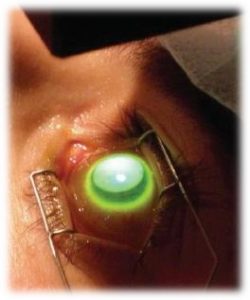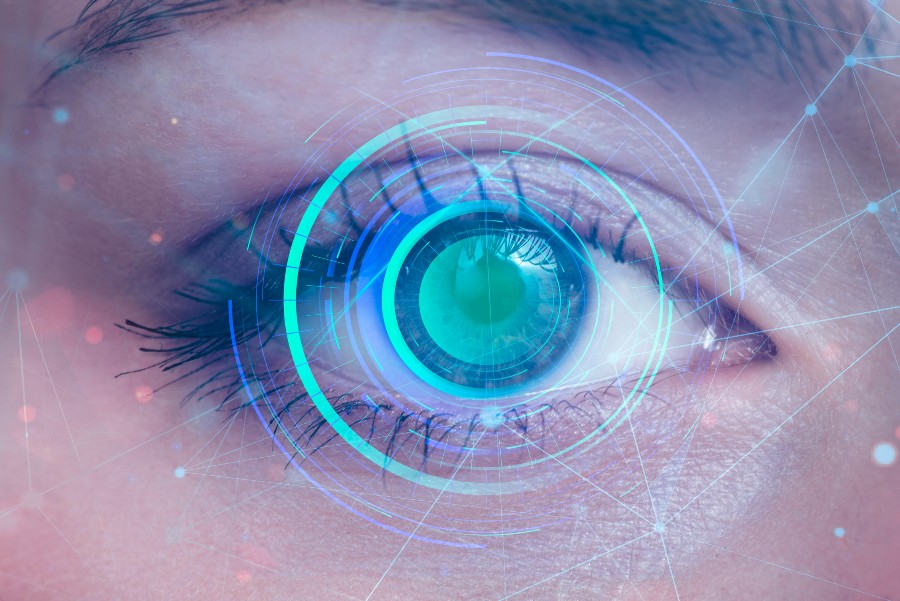
Corneal Cross Linking, which stops the treatment and progression of keratoconus has been used frequently for the last 5 years. Ultraviole A and Riboflavin are used in this treatment method and thus the structure of the cornea is strengthened. Corneal Cross Linking in short; the main goal of thia treatment is to strengthen the corneal structure and to stop the disease.
Some tests should be performed before CCL treatment. These examinations can be listed as follows:
- Measuring visual acuity with or without glasses
- Refraction with and without dilating drops
- Thickness of the cornea
- Corneal topography
- Fundus examination
HOW IS CCL TREATMENT APPLIED?
In order to apply CCL treatment, it is necessary to determine whether the disease is progressive or not. Corneal Cross Linking (CCL) treatment can be applied later if the disease is diagnosed as progressive.
How is this treatment applied?
VITAMIN RIBOFLAVINE / B2:
First, topical anesthesia is performed and the eye is anesthetized with drops.
After the topical anesthetic drops, the epithelium of the cornea is mechanically removed with spatula or alcohol.
After this procedure, riboflavin, vitamin B2, is applied on the cornea with 2 drops in 5 minutes intervals. This is a 30-minute process.
UV LIGHT APPLICATION:
- After 30 minutes, the patient is placed on a biomicroscope.
- Then, riboflavin fluorescence is seen in the anterior chamber and the light is applied for 30 minutes at a distance of about 7 millimeters from a distance of 4-5 cm.
- During this procedure, 2 drops of Riboflavin are applied to the eye every 5 minutes.
- Lastly, bandage is applied to the eye but the eye is not closed.
After these procedures, the eye heals completely after 3 days. During this 3-day period, the patient may feel pain, stinging and burning. After the treatment, drop medication is used for 1 month.
WHAT HAPPENS AFTER THE CORNEAL CROSS LINKING APPLICATION?
Pain may be felt in the eye for approximately 3 days after the Corneal Cross Linking treatment. When the effect of the anesthesia passes, burning and stinging occurs. Immediately after surgery, severe pain, redness, swelling of the eyelids and blurred vision may occur for approximately 5-6 hours. These are extremely normal effects. To deal with such situations, you should rest in the dim light as soon as you go home. However, you can take painkillers, you can apply cold to the eyes with the eyes closed. On the 1st and 3rd day of the surgery, a control is performed and the lens for protective purposes is removed. This will improve the stinging and blurred vision. After corneal cross-linking, the keratoconus will no longer progress, so the cornea will not become thinner day by day. There may be a desire for itching in the eye during the healing process but the eye should not be rubbed or scratched.
WHAT WILL CHANGE?
With Corneal Cross Linking (CCL), you will step into a recovery process. Blurred vision will occur for 7 to 10 days after treatment. In the first month, you can see sometimes clear and sometimes blurry. Corneal Cross Linking treatment, strengthens the tissues of the cornea. The quality of vision will become clearer in the future. Approximately 3 months after surgery, a doctor should check the eyes. However, you should also follow the treatment methods planned by your doctor for 6 months.
RETURN TO NORMAL LIFE AFTER THE SURGERY
You can return to your normal life from the third day after surgery. Of course, this is related to the person’s body. Some people come to their senses in 3 days, while others need more time for this. After a 7-day rest, you can return to work.

